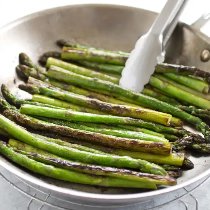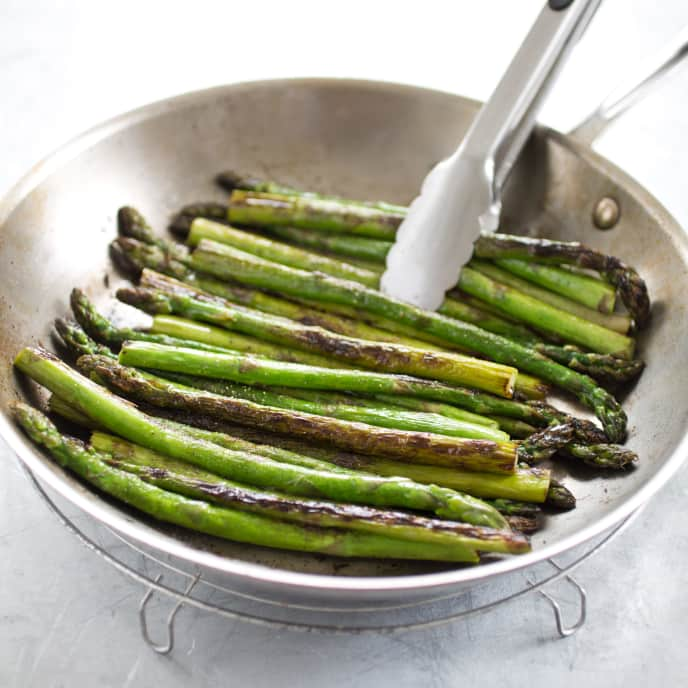Asparagus is a sure sign of spring in the upper Midwest and many home gardeners can’t give it away fast enough! Fresh local asparagus is so delicious, all it needs is to be simmered in water and served with butter. Below are many ways to prepare fresh asparagus.
Ways to prepare asparagus
Storage: Store asparagus, stalk side down, in a vase or jar of water like a bouquet. Loosely drape a plastic bag over the top, which will help keep tips from drying out but allow air to circulate, and put in the fridge for up to four days. If you don't have room for that, wrap the ends in a damp paper towel and put asparagus in a storage bag. For the best flavor the sooner you cook the asparagus, the better.
Peeling: Asparagus has a tough, impermeable wax cuticle skin or peel that protects it from losing moisture but it makes seasoning the spears hard for us. Peeling the most fibrous parts of the stem and braising (see below) leads to the most tender asparagus you’ve ever had and it’s simple to do.
Snap or Cut? The bottom of the spear is the most fibrous. According to America's Test Kitchen, “snapping (the bottom) off is wasteful and unreliable. Where the spear breaks depends on where you apply force. Using a knife is better. Cut an inch from the bottom of the spears and then check to see what remains. It may be nice and moist looking. If not, use your vegetable peeler to remove some of the fibrous skin at the lower end. The picture above and some of the cooking methods below come from America's Test Kitchen and Dan Souza's short "What's Eating Dan?" youtube video on asparagus.
- Raw Using thicker spears, rinse in cool water, pat dry and use your peeler to make thin, beautiful shavings all along the length of the spear. These shaved pieces add texture to a salad with lettuce, watercress, prosciutto and nuts in a large bowl. Toss with a sherry vinegar vinaigrette or any oil and vinegar combination you like.
- Blanch This method can be used if you plan to freeze asparagus. You can use blanched asparagus in a pasta, rice, seafood or green salad. Add it to frittata or a potato pancake, wherever you might like a touch of green. Blanching tenderizes the stalks and retains the bright green color.
Bring a large pan of salted water to a boil. Carefully lower the asparagus into the boiling water. Cook for 2–4 minutes, depending on the thickness of the stems. Using tongs or a skimmer, remove the asparagus and plunge it into iced water for at least 5 minutes. To freeze blanched asparagus: drain, pat dry, lay the asparagus on a tray. Freeze until frozen solid before putting in an airtight freezer bag.
- Saute: To sauté whole asparagus spears, add 1 to 2 T oil to a large skillet set over medium-high heat. Add the prepped asparagus, a generous pinch of salt, and toss to coat the spears. Allow the stalks time to take on some color, shaking the pan occasionally for about 5 minutes. Season with Salt and Pepper and lemon zest and juice.
-
Grill or Oven Roast. This brining/roasting method is good for thick spears so they can be on the grill longer without overcooking. Seasoning evenly can be tricky, as salt bounces off the surface. Rinse the spears clean, cut off about 1” from the bottoms. Next, poke each spear all over with a fork and drop into a brine of 4 cups water and ½ cup kosher salt. Let soak for 45 minutes to an hour. Dry and put them on a clean grill. Turn after about 6-7 minutes on each side. For oven roasted asparagus, put brined (or seasoned) spears on a sheet pan. In an oven preheated to 425 degrees F, the asparagus should be perfectly roasted after about 12 to 15 minutes. Turn half way through, Enjoy the smell as they char. Can be served with a dollop of lemon aioli and a sprinkle of sliced almonds.
-
Grill or Roast in Foil: This method results in a softer, steamed asparagus stalk with no char marks or clean-up! First rinse, trim and pat dry the asparagus. Next, place the asparagus stalks in the center of a large piece of aluminum foil and season with oil or butter and garlic, parsley, salt to taste. Fold the two longer sides of the foil together and tightly seal them together. Then, fold the ends into themselves, sealing tightly so the oil will not seep out. Grill the asparagus packet for 15-20 minutes depending on your desired tenderness. Flip the packet over with tongs halfway through cooking. Be careful when removing and opening the foil, as it will be hot and full of steam.
- Braising/Cooking in liquid This recipe by Cook’s Illustrated Keith Dresser is a delicious way to being out the best in asparagus. After braising in a flavorful liquid for almost 15 minutes, the spears trade their crispness for a silky tenderness and their grassy flavor for a sweet, nutty flavor and that bright green color for a subdued greenness. Cut off the bottom inch and peel two thirds of the way up the stalk. (Peelings can be saved to make asparagus soup!) This prevents water loss. Peeling and braising also leads to the most tender asparagus you’ve ever had and it’s simple to do. Add asparagus to a wide skillet with water, broth, oil and salt. Cover and simmer vigorously until tender about 10 minutes. Remove the lid and continue to cook until the skillet is almost dry and asparagus is beautifully glazed. Add a bit of lemon zest and a splash of lemon juice, chopped chives, salt and pepper.
- Air Fry: Cut off the ends of the stalks and line up 2 pounds of asparagus in one layer in your air fryer. Sprinkle with 1 T oil of your choice, ½ tsp each of garlic powder, dry parsley and salt. Sprinkle with 1/3 C of good grated parmesan. Fry at 400 degrees Fahrenheit for 7 minutes or until golden brown. Add more parmesan, if you like!
If you would like to be notified when we share new recipes, be sure to scroll to the bottom, provide your email address, check the box confirming you are not a robot, click on a few photos to prove it and click subscribe! You will then receive an email after each new post. Remember, we're always looking for new recipes, so keep sending them to ecopact@fspa.org!
What is your favorite way to eat asparagus and other spring vegetables?
Story:
Asparagus is a sure sign of spring in the upper Midwest and many home gardeners can’t give it away fast enough! It can also be found growing wild in some climates. More on foraging wild asparagus below.
America’s Test Kitchen writes, “Asparagus is a perennial, which means that it returns every spring wherever it’s been planted. It takes a few years to produce but often can be harvested every year for up to 10 years. If asparagus is grown in a region where it can produce spears throughout the year, it grows more spindly and less vigorous with each passing year. In colder or drier climates, it gets a chance to rest.
“Asparagus has been revered as a vegetable since Roman times and it shows up in the oldest surviving book of recipes. Its large native range stretches east to from Spain to central China, and north to south from Siberia to all the way down to Pakistan, but it has found adoptive homes across the world” says America’s Test Kitchen’s Den. There are decades old debates about which town or region owns the title of Asparagus Capital of the world.
Varieties: “Green asparagus is the most common. Purple asparagus is a different variety which gets its color from anthocyanins, the same pigments in purple cabbage, purple grapes and purple foods of all kinds. White asparagus is the result of a different growing method called blanching. Soil is mounded around the spears as they grow to block sunlight. That limits photosynthesis which keeps chlorophyll from forming. White asparagus is particularly prized in France and Germany for its delicate flavor and tenderness.
“Beyond color, the biggest difference between spears is usually thickness. Some are skinny, pencil-thin, and some are thick like small sausages. You can’t leave a skinny spear in the ground longer and hope it turns into a thick spear. It is determined by two factors: the age of the entire plant and its variety. So which size is preferable? If you remove the woody bottom of fat and skinny spears and taste them side by side, simply steamed, both will taste sweet, nutty and grassy. The thick spears are more tender, have better texture because the fibrous texture takes up a larger proportion in a skinnier spear.
Foraging for "wild" asparagus: Forager Euell Gibbons wrote of his passion for wild foods of all kinds in Stalking the Wild Asparagus. Ashley in Practical Self - Reliance reminds us that "there’s nothing wild about wild asparagus...Asparagus is not native to the US. It came over with European settlers. Once garden asparagus started going to seed the birds, attracted to the bright red asparagus 'berries'" spread the seeds... It's easier to "stalk" asparagus in areas when it is out of season and too big to harvest. It is often found along roadsides, at the edges of woodlands, and just about anywhere that gets good sun but a mower can’t regularly reach...Once found, you can remember those spots and look in early spring for the young stalks to poke out their heads."






Post a Comment